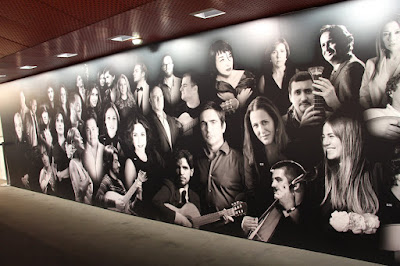Largo do Chafariz de Dentro, N.º 1
1100-139 Lisboa
Tel +351 218 823 470
Fax +351 218 823 478
Email info@museudofado.pt
Tuesday to Sunday, from 10 AM to 6 PM (last admission: 5.30 PM).
Closed on 1st of January, 1st of May and December 25th.
Documentation Centre
Monday to Friday, from 2.30 PM to 6 PM. (by previous appointment)
Museum School
Monday to Friday, from 2 PM to 8 PM
The Portuguese worldwide famous genre of music Fado has been also in the list of World’s Intangible Cultural Heritage of UNESCO. The permanent exhibition of Museum of Fado drags the visitors into the depths of Portuguese culture in its melancholic way by introducing visitors with fado and its origins by several kinds of displays, installations, audio-visual presentation, discs, re-created guitar workshop, paintings and even with Fado graffitis on its walls. The museum is located in Alfama where considered Fado was born with the working-class districts in.
The museum welcomes you with huge white and black posters of the Fado singers - from the very early times till the contemporary time - in the entrance with the two floor view which is enough to trigger your curiosity besides excitement. The display of the posters and the opening is pretty much impressive that you find yourself in the middle of nostalgic and mysterious world of fado with your first step.

An audio guide companies the visitors with four language (in Portuguese, English, French and Spanish) guide during the museum tour. Within the first room besides the posters you are introduced with the primordial origins of fado including the fado dance which is ‘lundum’ in early 19th century with detailed information and images. Since fado is known mainly as the typical music of Portugal this new information takes interest at once because it is not really known even by a Portuguese citizen. Here be prepared to witness how the passionate and love of fado can be incredibly strong.

After introducing with the evaluation progress of fado from the sentimental traditional song such as “Modinhas” the visitors continue their visit with graffitis on the wall. Every touch in the museum is now ready to reveal the passionate of Fado and its meaningful harmony with “saudade”, love and emotions.

“The guitar shall not warm
Although you sing with pride
If it is not about love
Every guitar gets cold”
Although cheerful fado exists and can be listened in the Museum the atmosphere is mainly melancholic with the exposure of emotions to the sound of a guitar. Fado is clearly associated with the word “saudade”. Saudade does not have a direct translation in English (longing has closer meaning), but in Turkish can be replaced with the word “hasret” which means a very strong feeling of missing someone of something.
The painting of oil on canvas of contemporary art by Constantino Fernandes reflects the moments of expression of fado with saudade. Fado theme reflected to the Portuguese contemporary art by the artist Constantino Fernandes in 1920s as it can be seen the canvas of “The Sailor” below. We witness the departure moment, “saudade” revealed by the Fado singing with Portuguese guitar and meeting moment through the canvas.

O Marinheiro, by Constantino Fernandes, 1913
Besides absorbing paintings such as the paintings of Julio Pomar, José Malhoa, the museum supplies a wide offer of Fado recordings, books, discs, postcards, musical instruments, Fado room within rich fado collection, companying with the biography of the famous fado singers.

On the other hand the visitors will find the process of the hand work to make the Portuguese guitar with a big screen and the non-completed pieces of the guitars by a workshop with the company of Fado.

Besides the musical and cultural aspects the museum takes you into a journey about the political history of Portuguese dictatorship and with some clues of the position of the art against the fascism of Salazar. As a country which has The Carnation in history the museum makes his best reflecting the Salazar era with the oppression. The art pieces reflect prohibitions of the related term and objectivation of women body and the difficulties women had to face with several limitations stucked in their houses.


In a cinema saloon along with the display of short documentary about fado the most famous fado singers such as Mariza, Jose Manuel Neto express their passionate in singing of fado. Well, actually they cannot. Referring to the discourse of Amelia about fado “ A strange way of life” it is pretty much difficult describe the fado. Because as the famous artists state fado cannot be described, it can be felt inside. It cannot be taught but can be learned. Because it is all about feeling, all about ‘saudade.
I took the liberty to state the flaw of the museum is the arrangement of the path and the disharmony of the floors organizing. During the museum tour the visitors get lost in the melancholic atmosphere of Fado but to pass through the last display you must go to the downstairs to the basement floor which pulls you off from the entire atmosphere the museum created during the whole tour.
Aiming to significantly increase the quantity and quality of the information offered to the visitor the museum drags you into alive and dynamic environment with all freshness and technical developments which definitely worth to see and feel. Despite of the disappointing end of the tour it is fair to refer that The Museum of Fado is a key opens the door of deep Portuguese culture and historical background in an artistic way. I definitely suggest the reader to taste the atmosphere and feel drunk of Fado so that when you leave the museum you will have fresh eyes to see the city with more love and ‘saudade’.